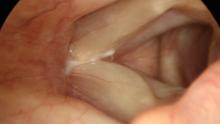This is an abstract I have submitted for the Fall Voice Conference in San Antonio, Texas.
Individuals undergoing a surgical reduction of the thyroid cartilage frequently known as a tracheal shave are at risk for the complication of vocal cord detachment at the anterior commissure. While the typical complaint is often hoarseness, presenting symptoms can be more precisely elicited. There is a drop in comfortable speaking pitch. Associated with this is a reduction in overall vocal range, and the range is also shifted lower. There is typically a loss of volume and vocal power. There is a reduction in vocal durability and an increase in vocal strain or effort.
Visually the endoscopic examination will reveal convex vocal cords, which are often confused with smoker's polyps both because of their appearance and because of the lower-than-expected comfortable speaking pitch. Many also attribute (confuse?) this convexity with the mysterious diagnosis of reflux laryngitis. Of note, this visual "edema" does not resolve with anti-reflux treatment.
Post tracheal shave hoarseness can occur because of edema or ecchymosis of the vocal cords. This pitch drop and hoarseness will be of a short duration, typically less than 7-14 days. Hoarseness and pitch drop that last longer than 7 to 14 days are more likely due to anterior commissure detachment. Depending on the degree of detachment, the patient may note some recovery. While initially the detachment allows for elasticity at the anterior commissure when tightening the vocal cords, later formation of scar tissue over 6 to 12 months allows for additional tightening by the cricothyroid and thyroarytenoid muscles. Recovery may be incomplete and consequently the complication remains unrecognized.
Performing a cricothyroid approximation at the same time or later may increase the risk of this complication, since it adds additional tension on the anterior commissure.
Repair can be made by an anterior laryngofissure. This may range from simple vertical splitting the thyroid cartilage in the midline to a reconstruction of the anterior thyroid cartilage. The goals of the patient need to be taken into account since the tracheal shave is often associated with the desire for a higher or more feminine speaking pitch in transgender patients. A simple split with sutures placed through the anterior commissure and tightened over an external plate can restore the original pitch. In the case where a wide portion of the thyroid cartilage was removed over the anterior commissure, the central inferior portion of the thyroid cartilage can be removed and the thyroid alae brought back to the midline to reconstruct a solid anterior thyroid cartilage. Additional anterior vocal cord can be removed to provide further tightening and shortening of the vocal cords in order to raise comfortable speaking pitch.
Goals:
1) Recognize anterior commissure detachment when a history of tracheal shave is present.
2) Understand at least one proposed surgical technique for reconstructing the vocal cord's attachment and restoring a more normal voice and vocal range.
3) Differentiate by vocal capabilities and endoscopy, smoker's polyps and detached vocal cords

